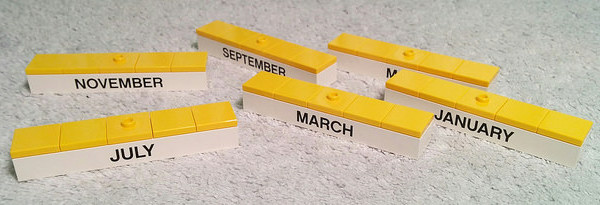
If you’re getting ready to take the GRE, you should first know the GRE syllabus: exactly what this test is trying to measure, what content it covers, and what kinds of questions you’ll be asked.
In this complete GRE exam syllabus, I’ll take you through the format of the three sections of the test, explain the differences between the computer and the paper versions of the GRE, and then give you detailed examples and explanations of every kind of question you’ll encounter. Finally, I offer some tips on getting started with your GRE prep.
If you want to hop ahead, here are the syllabi for the three sections of the GRE:
The Format of the GRE
Before we go in-depth into each of this exam’s three sections, let’s briefly break down the format of the computer GRE and the paper GRE.
(For a much more detailed look at the format of the GRE, check out our GRE Format article.)
Most people will take the GRE on the computer. But, in places where there is no access to the computer-based GRE, a paper version of the GRE is still available three times a year. There are important differences between the way the test is administered via computer and on paper.
Quick side note: we've created the world's leading online GRE prep program that adapts to you and your strengths and weaknesses. Not sure what to study? Confused by how to improve your score? We give you minute by minute guide.
You don't NEED a prep program to get a great GRE score. But we believe PrepScholar is the best GRE prep program available right now, especially if you find it hard to organize your study schedule and don't know what to study.
Click here to learn how you can improve your GRE score by 7 points, guaranteed.
Computer GRE Test Format
The computer GRE test is broken up into the following sections:
- Analytical Writing
- Verbal Reasoning (2 sections)
- Quantitative Reasoning (2 sections)
- Unidentified and unscored experimental section
- Identified research section
Computer GRE Sections
The first section of the GRE is always Analytical Writing. This is a one-hour section that consists of two 30-minute essay parts: “Analyze an Issue” and “Analyze an Argument.” You can only use up to 30 minutes for each of the essays – in other words, if you finish the first essay early, you can’t use your leftover time on the other essay.
The next five sections of the GRE can appear in any order at all.
Four of these five sections will count towards your score: two Verbal Reasoning sections, each with 20 questions you have to answer in 30 minutes; and two Quantitative Reasoning sections, each with 20 questions you have to answer in 35 minutes.
You may also see an extra Verbal or Quantitative section that will not count toward your score because it is testing out potential future questions. However, the experimental section will not be identified as experimental. Instead, it will look exactly like one of the Quantitative or Verbal sections, and it can appear at any time after the Analytical Writing section. You will not be able to tell which one it is, so you must approach all the sections as though they count.
You may also see a clearly marked and identified research section at the end of the test. It may have differently designed test questions than the rest of the test.
Computer GRE Timing
Overall, you have about 3 hours 45 minutes to take the computer GRE. There is a 1-minute break after each GRE section, as well as a 10-minute rest break after the third section. All breaks are optional, meaning you can use the entire break time to rest, use only part of each break time, or take no break at all.
| Analytical Writing (One section with two separately timed essays) | 1 “Analyze an Issue” essay 1 “Analyze an Argument” essay | 30 min per essay |
| Verbal Reasoning (Two sections) | 20 questions per section | 30 min per section |
| Quantitative Reasoning (Two sections) | 20 questions per section | 35 min per section |
| Unscored Unidentified Experimental Section | Varied | Varied |
| Unscored Identified Research Section | Varied | Varied |
The Computerized GRE Is an Adaptive Test
The second Verbal and Quantitative section you see on the test will be different, depending on how well you did on the first Verbal and Quantitative section you took. In other words, the GRE adapts the difficulty of the questions you see based on your past performance.
For example, you’ll start with a medium-difficulty Verbal section. Then, depending on how well you did, the second Verbal section that counts for your score will either be an easy, medium, or hard section. The same goes for the two scored Quantitative sections.
If you end up with an easy section, you limit how high you can score on that part of the GRE. Only those who get to the difficult second sections of their tests will be able to get the top scores.
But, since the GRE is not adapted from question to question, this means that you can move back and forth between questions within each section. You can breeze through and answer the easier ones, and then come back for the more challenging ones.

Paper GRE Test Format
The paper GRE is the same in content and very similar in structure. But there are some key differences.
The paper GRE always starts with the Analytical Writing section. This section is divided into two 30-minute essays.
The next four sections can be in any order: two Verbal Reasoning sections, each with 25 questions that you have to answer in 35 minutes; and two Quantitative Reasoning sections, each with 25 questions that you have to answer in 40 minutes. (Note that the timing of these sections differs from the computer GRE.)
There are two more big differences between the computer and the paper GRE. First, there are no experimental or research sections on the paper GRE, so each section you see counts toward your overall score. Second, the paper test is not adaptive.
You’ll have about 3 hours 30 minutes for the paper GRE, with a 10-minute break after the second section.

Complete GRE Syllabus, Section By Section
Now that I’ve laid out the basic format of the GRE, let’s examine its three sections in detail.
Analytical Writing Section GRE Syllabus
On the GRE Analytical Writing section, your job is to write two essays, using all the critical thinking, reasoning, and writing skills that you’ll be using later in graduate school. Because of this, the essay sections don’t have a “right” answer – instead, they measure how well you can make a compelling argument in writing
This means that both of your essays will need to show that you can write well, in terms of both form and content.
Your content must show that you can structure your thoughts coherently: construct an overarching argument, break the argument down into logically progressing ideas, explain each of those ideas, and back up your explanations and logic with convincing, specific examples. However, luckily, your writing doesn’t have to show mastery of any particular subject – all the facts and details will be general-knowledge based.
Your essays’ form must also display your ability to express yourself clearly: use appropriately formal and elevated language, vary sentence length and structure with style, and make few spelling and grammar mistakes. (There’s no spellchecker in the GRE software, so some flubbed words are expected – but if your whole essay is an unreadable mess, that’s a problem.)
Overall, both Analytic Writing essay tasks are testing your ability to use logic, but in two totally different ways. Let’s look at each of the essays in turn.
What Is the “Analyze an Issue” Essay Testing?
The Issue essay task prompt consists of two parts. The first part is a general statement that presents an opinion on a particular issue. The second part is a writing prompt that asks you to take a position on that statement and to present a logical argument about your chosen position.
A good way to think of the Issue essay is to imagine yourself in a debate: you choose a side and then have to convince someone else that you’re right.
“Analyze an Issue” General Statements
Here are two examples of general statements, which will always come from this collection of Issue statements:
You can see that both statements articulate two fairly complex policies in very simple, almost black-and-white terms. The GRE does this so that you can easily argue the issue from various different points of view.
Want to improve your GRE score by 7 points? We have the industry's leading GRE prep program. Built by world-class instructors with 99th percentile GRE scores, the program learns your strengths and weaknesses through machine learning data science, then customizes your prep program to you so you get the most effective prep possible.
Try our 5-day full access trial for free:
All the of the Issue statements are written in a categorical, non-nuanced way (for instance, by using words like “all,” “any,” or “never”). This makes each statement suggest that all situations are exactly the same and require the same solution – clearly a flawed approach to any complex issue. This is one great place to start looking for holes to poke in whatever the statement is saying.
The statements rely only on general knowledge of modern life and current events and do not require familiarity with any specialized fields. Because of this, the terms a statement uses (here, “national curriculum” or “those in power”) are extremely broad and generalized. Your essay will always benefit from more narrowly defining the broad terminology of the statement in a way that works with your argument.
“Analyze an Issue” Writing Prompts
Here is the list of possible writing prompts which will follow the Issue statement:
#1: Write a response in which you discuss the extent to which you agree or disagree with the statement and explain your reasoning for the position you take. In developing and supporting your position, you should consider ways in which the statement might or might not hold true and explain how these considerations shape your position.
#2: Write a response in which you discuss the extent to which you agree or disagree with the recommendation and explain your reasoning for the position you take. In developing and supporting your position, describe specific circumstances in which adopting the recommendation would or would not be advantageous and explain how these examples shape your position.
#3: Write a response in which you discuss the extent to which you agree or disagree with the claim. In developing and supporting your position, be sure to address the most compelling reasons and/or examples that could be used to challenge your position.
#4: Write a response in which you discuss which view more closely aligns with your own position and explain your reasoning for the position you take. In developing and supporting your position, you should address both of the views presented.
#5: Write a response in which you discuss the extent to which you agree or disagree with the claim and the reason on which that claim is based.
#6: Write a response in which you discuss your views on the policy and explain your reasoning for the position you take. In developing and supporting your position, you should consider the possible consequences of implementing the policy and explain how these consequences shape your position.
How you approach the essay will depend on which writing prompt you end up getting, so it’s really important to make sure to read the prompt carefully.
You don’t have to fully agree or disagree with the statement you’re given. Instead, as prompts 1-3 say, you can go for nuance and explain where on the agree-disagree spectrum you fall and why (“discuss the extent to which you agree or disagree”).
Notice that in Prompts 1-3, and 5, the examples being asked for are different. Prompt 1 wants situational examples – cases that either prove or disprove the statement itself. Prompt 2 wants examples that prove your point, whether you agree or disagree. So, here, you would pick and chose only those situations completely confirm your argument. Finally, Prompt 3 is the opposite of Prompt 2. It wants you to come up with examples that challenge whatever the position you take is.
In Prompt 4, it’s clear from the text that you would have gotten an Issue statement with two opposing arguments. This prompt expects you to be able to argue about the merits of one and the problems of the other.
In the case of Prompt 6, it’s all about the future. Here, instead of thinking of examples that help shape your opinion in the present, you are supposed to imagine outcomes and argue based on them.

What Is the “Analyze an Argument” Essay Testing?
Like the Issue essay, the Argument essay task prompt also consists of two parts. The first part is a paragraph-long argument that seems to be using logical reasoning to defend a position. The second part is a writing prompt that will ask you to pick apart the paragraph’s position, logic, and evidence.
You can think about the Argument essay as the reverse of the Issue essay. Instead of coming up with your own position on a topic, you have to find all the holes someone else’s work.
This means you need to be able to:
- Identify and evaluate evidence and examples used by the passage.
- Explain whether the conclusions of the passage make sense or not – and why not.
- Verify that the underlying assumptions of the passage actually need to be proven instead of simply assumed.
- Examine whether the flow of the argument is logical and whether the thinking used to get from each point to the next works.
It’s good to remember that this essay is about the structure of the passage you’re writing about. It doesn’t matter whether the paragraph’s argument or facts are true or not, or whether you agree with it. All you need to do is make a solid judgment about its coherence, logic, and cogency.
“Analyze an Argument” Topics
Here are two examples of the passages you have to analyze in an Argument essay, which will always come from this list of Argument essay topics:
The following is a memorandum from the business manager of a television station.
“Over the past year, our late night news program has devoted increased time to national news and less time to weather and local news. During this time period, most of the complaints received from viewers were concerned with our station’s coverage of weather and local news. In addition, local business that used to advertise during our late-night news program have just cancelled their advertising contracts with us. Therefore, in order to attract more viewers to the program and to avoid losing any further advertising revenue, we should restore the time devoted to weather and local news to its former level.”
Write a response in which you examine the stated and/or unstated assumptions of the argument. Be sure to explain how the argument depends on these assumptions and what the implications are for the argument if the assumptions prove unwarranted.
The following appeared as part of a letter to the editor of a scientific journal.
“A recent study of eighteen rhesus monkeys provides clues as to the effects of birth order on an individual’s levels of stimulation. The study showed that in stimulating situations (such as an encounter with an unfamiliar monkey), firstborn infant monkeys produce up to twice as much of the hormone cortisol, which primes the body for increased activity levels, as do their younger siblings. Firstborn humans also produce relatively high levels of cortisol in stimulating situations (such as the return of a parent after an absence). The study also found that during pregnancy, first-time mother monkeys had higher levels of cortisol than did those who had had several offspring.”
Write a response in which you discuss one or more alternative explanations that could rival the proposed explanation and explain how your explanation(s) can plausibly account for the facts presented in the argument.You can see that both statements use formal language to state what appears to be a logical progression of evidence and conclusions drawn from that evidence.
As the writing prompts point out, the paragraphs are riddled with all sorts of flaws.
Depending on what the writing prompt asks you to do, you will have to look at the paragraph with a skeptical eye towards whichever of the flaws you are supposed to be dissecting.
Often, what is lacking is convincing evidence. Sometimes, there isn’t enough information to actually draw the conclusions that the argument is drawing, in which case you could suggest other data that could be collected to test the conclusions. Other times, the evidence is being interpreted in only one way, excluding other explanations. In this case your job is to suggest alternate possibilities for the facts being described.
Other times, you will instead have to pull apart the unstated principles on which this argument is based. If the paragraph assumes value judgments (for example, that one type of thing is better than another), you can question whether this judgment is correct. If the paragraph relies on connections between ideas that don’t actually follow one another, your essay can point this out.
“Analyze an Argument” Writing Prompts
Here is the list of possible writing prompts which will follow the Argument topic paragraph:
1. Write a response in which you discuss what specific evidence is needed to evaluate the argument and explain how the evidence would weaken or strengthen the argument.
Want to improve your GRE score by 7+ points?
Check out our best-in-class online GRE prep program. We guarantee your money back if you don't improve your GRE score by 7 points or more.
PrepScholar GRE is entirely online, and it customizes your prep program to your strengths and weaknesses. We also feature 2,000 practice questions, official practice tests, 150 hours of interactive lessons, and 1-on-1 scoring and feedback on your AWA essays.
Check out our 5-day free trial now:
2. Write a response in which you examine the stated and/or unstated assumptions of the argument. Be sure to explain how the argument depends on these assumptions, and what the implications are for the argument if the assumptions prove unwarranted.
3. Write a response in which you discuss what questions would need to be answered in order to decide whether the recommendation and the argument on which it is based are reasonable. Be sure to explain how the answers to these questions would help to evaluate the recommendation.
4. Write a response in which you discuss what questions would need to be answered in order to decide whether the advice and the argument on which it is based are reasonable. Be sure to explain how the answers to these questions would help to evaluate the advice.
5. Write a response in which you discuss what questions would need to be answered in order to decide whether the recommendation is likely to have the predicted result. Be sure to explain how the answers to these questions would help to evaluate the recommendation.
6. Write a response in which you discuss what questions would need to be answered in order to decide whether the prediction and the argument on which it is based are reasonable. Be sure to explain how the answers to these questions would help to evaluate the prediction.
7. Write a response in which you discuss one or more alternative explanations that could rival the proposed explanation and explain how your explanation(s) can plausibly account for the facts presented in the argument.
8. Write a response in which you discuss what questions would need to be addressed in order to decide whether the conclusion and the argument on which it is based are reasonable. Be sure to explain how the answers to the questions would help to evaluate the conclusion.
There are several things that are important to notice.
Some prompts ask you to create questions that need to be answered (3-6, 8), while others ask for missing pieces evidence (1). These are basically the same thing, except you’ll need to phrase your answer differently. In other words, you can use the same flaw with the argument paragraph to answer both kinds of prompts, if you make sure to either phrase your point as a question, or to suggest a test, poll, or other piece of information that would be useful.
Prompt 2 wants you to focus on underlying assumptions in the statement. These are statements that aren’t necessarily actually spelled out, but the argument relies on them being true. Underlying assumptions come into play when an argument posits the relative value of two or more things, when it assumes a norm or standard of behavior, or when it supposes only one plausible explanation for a phenomenon.
Prompt 6 is all about the future, asking you to judge the statement’s ability to predict what will happen. This means that you will have to project following the advice being advocated for in the argument paragraph on a given situation.
Prompt 7 wants you to play devil’s advocate, and to come up with a different (and maybe better) story that connects the dots in the statement.

Verbal Reasoning Section GRE Syllabus
Unlike the Analytical Writing sections, which were testing whether you could do the kind of the writing that will eventually be required in grad school, the Verbal Reasoning section tests a more basic ability to read and understand formal prose.
The questions you’ll face on the GRE Verbal Reasoning section are trying to see whether you can understand and draw conclusions from written material, see how logic works within a paragraph, and use a variety of elevated vocabulary and its usage.
Each 20-question Verbal Reasoning section will be divided into three kinds of questions. Here’s the complete GRE exam syllabus:
- Text Completion questions ask you to pick appropriate words to fit into blank spaces left in a sentence.
- Sentence Equivalence questions ask you to find two synonymous words or phrases to complete a sentence.
- Reading Comprehension questions ask you to read several passages and answer questions about them.
We’ll go through each one.
What are Text Completion Questions Testing?
Questions in this category are all about knowing what words mean and how to use them correctly in sentences. The questions will show you a short passage (1-5 sentences) with 1-3 words missing. You’ll have to pick the best choices to fill in those missing words. To get the question right, you have to pick the right words for all of its blanks.
Here’s an example of a Text Completion question with only one blank:
You can use the last half of the sentence (particularly words like “not know” and “hidden”) to understand that the way the land turns into ice is hard to detect. This means the right answer is “imperceptibly” – the only word that means “difficult to perceive.”
Here’s an example of a Text Completion question with three blanks: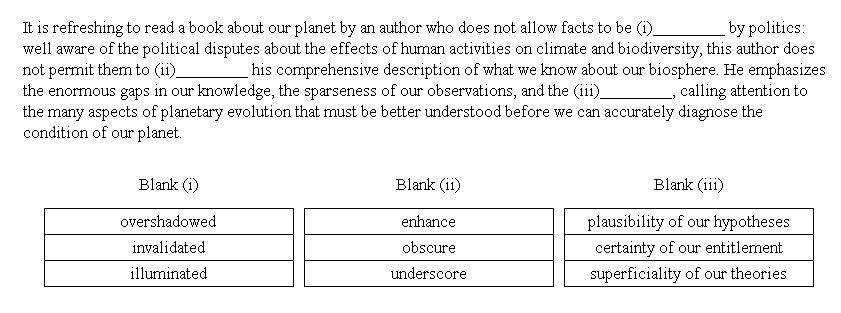 Here, the author seems to be complaining about the way political considerations tend to interfere with scientific discussions of climate change. So that means you have to find words that support this argument trend. The first blank is straightforward – it’s the thesis that explains the problem when politics matters more than science, so the answer to Blank (i) is “overshadowed.” Blank two is a clause that expands on the original point, again pointing out how bad it is to let politics cloud what science reveals, so the answer to Blank (ii) is “obscure.” The last blank is a sentence that moves away from the politics vs science thing and instead talks about three matching terms: the “enormous gaps in our knowledge,” the “sparseness of our observations,” and the answer, which will have to also be something about how we don’t know enough. So the answer to Blank (iii) is “superficiality of our theories.”
Here, the author seems to be complaining about the way political considerations tend to interfere with scientific discussions of climate change. So that means you have to find words that support this argument trend. The first blank is straightforward – it’s the thesis that explains the problem when politics matters more than science, so the answer to Blank (i) is “overshadowed.” Blank two is a clause that expands on the original point, again pointing out how bad it is to let politics cloud what science reveals, so the answer to Blank (ii) is “obscure.” The last blank is a sentence that moves away from the politics vs science thing and instead talks about three matching terms: the “enormous gaps in our knowledge,” the “sparseness of our observations,” and the answer, which will have to also be something about how we don’t know enough. So the answer to Blank (iii) is “superficiality of our theories.”
What are Sentence Equivalence Questions Testing?
Think of this section as “synonyms,” because that’s basically what you’ll have to be looking for. Here, you’ll get just one sentence with one blank and you’ll have to find the two ways that you could complete the sentence and get the same meaning.
Here’s an example:
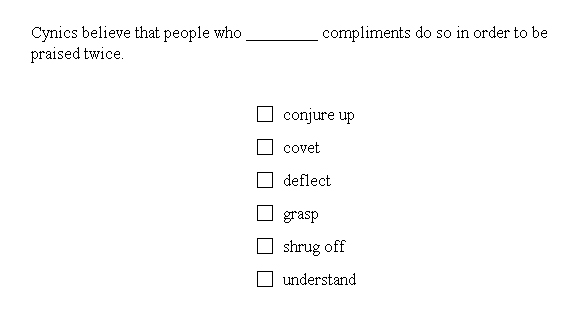
There are two strategies for solving these. Either we could find pairs of synonyms and see which ones fit into the sentence. Or we could first try to make sense of the sentence and then find the appropriate missing words.
In these answer choices, there are two pairs of synonyms: “deflect”/”shrug off” and “grasp”/”understand.” The sentence is talking about one of the ways that you could fish for compliments. “Understanding” a compliment wouldn’t lead to being re-praised. But “shrugging off” the first compliment in order to get another one works perfectly. The answers are “shrug off” and “deflect.”
What are Reading Comprehension Questions Testing?
About half of the Verbal Reasoning GRE syllabus is Reading Comprehension – questions based on passages anywhere from one to several paragraphs in length. The content of the passages can come from any number of disciplines: the sciences, business, arts and humanities, or any other formal writing you would find in a book or magazine. But don’t worry: you don’t need to know anything about the subject matter to answer the questions.
Instead, you’re being tested on your ability to follow the internal logic of a paragraph, understand what an author is trying to explain, draw conclusions from the passage, and make inferences about things that aren’t directly spelled out in the passage.
There are three Reading Comprehension question types:
- Multiple choice with only one answer correct answer (this is the most straightforward of the question types – you’ve seen this kind of Reading Comp question if you’ve taken any other standardized tests like the SAT or the ACT)
- Multiple choice with one or more correct answers, where you have to find all the right answers in order to get credit for the question
- Select-in-passage, where you have to find a sentence in the passage itself that best answers the question.
Here’s an example of a one-answer multiple-choice question:
The question is asking about the point of the passage. The first three answer choices aren’t discussed in the passage at all. The fourth answer choice is an inference you could draw from the way the passage seems to be defending Glass’s use of popular music, but the passage doesn’t actually talk about Glass’s reputation or standing. So the last answer choice is the right one, since the passage directly says that despite using popular music, Glass’s “symphonies’ sound is distinctively his” – i.e. not a copy of someone else’s.
Here’s an example of a multiple-choice question that has more than one answer:
Since any and all of the answer choices could be correct, you have to carefully find all the answers that apply.
The question wants to know how the passage describes Glass’s music. Answer choice 1 is correct – Glass is “reviving” using popular music in classical music. Answer choice 2 is wrong – the passage specifically says that Glass’s music is “not a version of popular music.” Answer choice 3 is right as well – the passage implies that Glass has been doing this kind of fusion during his whole career as a composer. So to get this question right, you’d mark answers 1 and 3.
Here’s an example of an in-passage question, where you have to click the sentence in the passage itself:
You have to find a sentence that talks about two different ways that rock and classical music can be combined. Only the last sentence of the passage fits this description – this is where the author describes popular music being written for classical audiences and classical music written to appeal to audiences more familiar with rock.

Quantitative Reasoning Section GRE Syllabus
The Quantitative Reasoning sections of the GRE test two different things. First, they are looking at your facility with basic algebra and geometry. And second, they are testing how you go about solving problems – how you apply logic to problems with numbers.
This means that you definitely should re-familiarize yourself with these math GRE syllabus topics:
- Arithmetic: integers (divisibility, factorization, prime numbers, remainders and odd and even integers), arithmetic operations (including exponents and roots), and concepts such as estimation, percent, ratio, rate, absolute value
- Algebra: exponents; linear and quadratic equations; simultaneous equations and inequalities; word problems
- Coordinate geometry: graphs of functions, and lines (equations, intercepts and slopes)
- Geometry: parallel and perpendicular lines, circles, triangles (including the Pythagorean theorem), polygons, congruent and similar figures, three-dimensional figures, area, perimeter, volume, and angle measurement
- Data analysis: basic descriptive statistics (mean, median, mode, range, standard deviation, interquartile range, quartiles and percentiles), interpreting data tables and graphs, probability (probabilities of compound events and independent events)
But this also means that many questions aren’t really about number crunching, but instead about figuring the problem out logically – with estimates, reasonable guesses, and inferences.
On each Quantitative section, you’ll see 8-9 quantitative comparisons questions, 8-9 problem-solving questions (two kinds of multiple choice and numeric entry), 3-4 data interpretation questions (which are either multiple choice or numeric entry questions about a table or graph). Let’s go over what these different question types are like.
What Are Quantitative Comparison Questions Testing?
These questions will give you two quantities to compare. You will first have to arrive at the value of each of the quantities, and then your job will be to figure out whether one of them is bigger than the other, whether they are equal, or whether there’s not enough info to know.
Here is an example of what this will look like: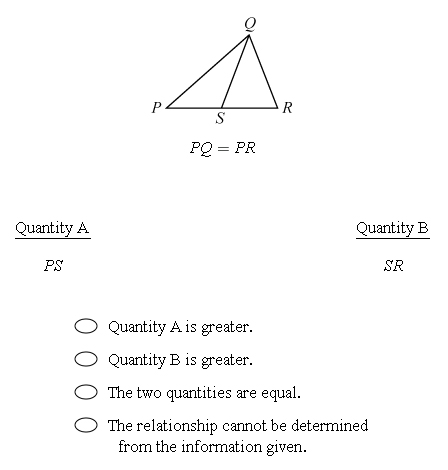
To figure this question out, you don’t really need to know a lot of geometry. You just have to use your logical thinking ability to realize that we have no idea how big angle PQS is compared to angle SQR. Nothing in the problem reveals this information. That means we don’t know exactly where line QS intersects line PR. It could bisect it exactly, or it could be closer to P or closer to R. So, the answer is the last choice – we don’t have enough information to know which of the line segments is bigger.
What Are the Multiple Choice Questions Testing?
Just like in the Verbal sections, the Quantitative multiple choice comes in two different flavors: questions that only have one right answer and questions that can have any number of correct answers – and you have to find all of them to get credit for the question.
Here’s an example of a 1-answer multiple choice question: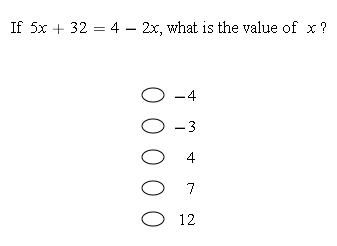
This question is all about your ability to manipulate a linear equation in order to solve for x:
(5x + 32) + 2x = (4 – 2x) + 2x
7x + 32 = 4
(7x + 32) – 32 = 4 – 32
7x = -28
x = -4
(So, the first answer choice is correct.)
Here is an example of the multiple-correct-answer type of multiple choice question: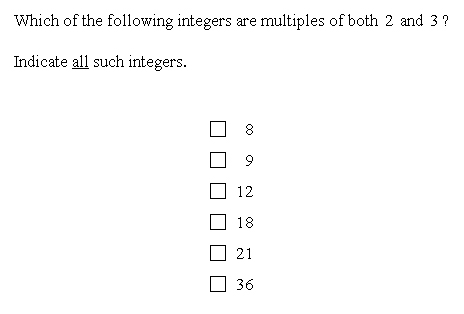
To solve this, you can do one of three things to see that the right answers are 12, 18, 36. First, you could simply go through each answer possibility and divide it by 2 and 3. Second, you could realize that numbers divisible by 2 are even, eliminate the odd numbers, and then find which even numbers in the list are divisible by 3. Or, you could realize that a number divisible by both 2 and 3 would have to be also divisible by their product (i.e. 6), and go through the list to find multiples of 6.
What Are Numeric Entry Questions Testing?
In these questions, there are no answer choices listed. Instead, you have to come up with your own answer – which will be either an integer, a decimal, or a fraction – and then type that answer into the box.
Luckily, the test software has a built-in calculator so you can avoid careless arithmetic mistakes.
Here is an example of a Numeric Entry Question (I’ve also included the available calculator in the screenshot):

To answer the question, you just have to rewrite the sentence into a bit of arithmetic:
(0.25 * 18) + (0.35 * 100)
Then you can either do the whole thing on the calculator, or realize that 0.35 * 100 is easy and equals 35, and just do 0.25 * 18 on the calculator, and then add 35 to it.
The answer is 39.5 (notice that the dollar sign is already written next to the answer blank. All you need to enter is the number itself).
What Are Data Interpretation Questions Testing?
Data Interpretation questions are groups of questions that are connected to one table or graph. Each of these questions will either be in numeric entry format, or in one of the multiple choice formats (since answer or multiple answer).
Note that depending on the type of graph used, you may be able to estimate the right answer.
Here’s an example of a problem that relies on data interpretation:
To solve this correctly, you have to understand how to connect the percent of change to the real value that this percent of change represents.
Here, since Store P started with $800,000 in 2006 grew by 10% from 2006 to 2007, that means that at the end of 2007, Store P had 110% of the dollar amount that it started with. So, ($800,000 * 1.1) = $880,000.
Now we do the same thing again with next year’s data. Store P started 2007 with $880,000, but then lost 10% of this value from 2007 to 2008. That means that at the end of 2008, Store P had 90% of the amount it had in 2007. So, ($880,000 * 0.9) = $792,000.

How Can You Use This GRE Syllabus to Study?
Now that you know exactly what the GRE tests and how its sections are designed, you can use this GRE exam syllabus to build a custom study plan just for you. Studying the right way for you is key to maximizing your score on this kind of test.
For one thing, since you know what each section will cover, you can lean harder in your study plan on your areas of weakness, rather than spending unnecessary time on the fields where you are strongest. For example, college math majors will probably need less prep time for the Quantitative section than those who focused on the humanities.
Also, your studying now can, and should, reflect the way in which the GRE will structure its questions. For instance, now that you know how much focus there will be on individual vocabulary words and how little focus on grammar, you can shift your attention to the appropriate drills and memory exercises.
Overall GRE Study Tips
So, how do you formulate a good GRE study plan that fits your needs?
First things first: if any of the topics I described in the “What’s Being Tested” sections in this article don’t ring a bell, refamiliarize yourself with them.
Next, take a practice GRE test. There are two full-length practice GRE tests that you can access through the ETS POWERPREP® II software. Take one, and then analyze your results carefully to see whether you are making repeated mistakes on similar concepts. This will give show you which fundamentals you need to know better before taking the second of the practice tests.
Analytical Writing Study Tips
Pick a few Analyze an Issue topics from ETS’s Issue topic pool and a few Analyze an Argument topics from ETS’s Argument topic pool, and then write essays as though doing the Analytical Writing sections. You may want to first write one or two essays untimed, and then introduce the 30-minute time limit for your second or third round of practicing.
Then, ask a friend to look over what you’ve written, rating your work based on the Argument and Issue scoring guides. Alternately, you could use ETS’s own computerized essay-grading software, ScoreItNow, for feedback (you can subscribe to this service for $20).
Verbal Reasoning Study Tips
Since half the questions on the Verbal Reasoning section will be Reading Comprehension questions, practice by reading the kind of analytical, academic, formal writing that you’ll encounter in these questions. I recommend a weekly deep dive into a few articles from Wired, Vox, The Atlantic. If you have access to a subscription, you can also read the New York Times, Time Magazine, or The New Yorker.
To drill yourself on the kinds of vocabulary words you’ll encounter on the other half of the Verbal Reasoning section, use flash cards to boost your word knowledge (for instance, we have a great set of SAT word flashcards). Then, take sentences from any of the recommended reading media above, pick out key words, and replace them with synonyms.
Quantitative Reasoning Study Tips
To brush up on any algebra or geometry concepts that are no longer fresh in your mind, either look over your own high school math textbooks, or use an online tool like Khan Academy to rebuild your knowledge.
At the same time, more broad reading will help you with the Data Interpretation questions. Articles in publications like Slate, or FiveThirtyEight (or, with a subscription, The Economist or the magazine Science) often come with graphs or charts to illustrate their points, which will give you great practice for seeing how to use this kind of data in context.
What’s Next?
Want to get started on your GRE studying? Use our guide to the best GRE study materials to help you prepare and raise your score!
Interested in learning more about how Khan Academy can help you prepare for the GRE? We have a guide that explains everything you need to know to use Khan Academy for your GRE prep!
Now that you’ve had an introduction to the GRE, learn how to prepare for the exam by reading our in-depth guide on how to make a GRE study plan, including four sample schedules to help you get started!
Ready to improve your GRE score by 7 points?
We've written a eBook about the top 5 strategies you must be using to have a shot at improving your GRE score.
Download it for free now:
